Major Spanish Wineries and Producers
Explore the best of Spanish wineries and producers. From traditional vineyards to modern estates, experience the essence of Spanish wine culture.

Spain's wine cellars are not only places where the delicious nectar is produced and stored but also harbour centuries of history, tradition and passion for the art of winemaking. From the majestic vineyards of the north to the sunny lands of the south, Spain is home to some of the world's most iconic and renowned wineries.
In this article we will explore some of the major Spanish wineries in depth, discovering their fascinating histories, winemaking innovations and the cultural heritage they have passed down through generations. Get ready to embark on a sensory journey through the unique aromas, flavours and landscapes that characterise these iconic wineries!
Best wineries in Spain
Here are some of the most esteemed wineries across various regions in Spain, known for their quality, history, and unique contributions to the world of wine:
Bodegas Torres – Vilafranca del Penedès, Catalunya
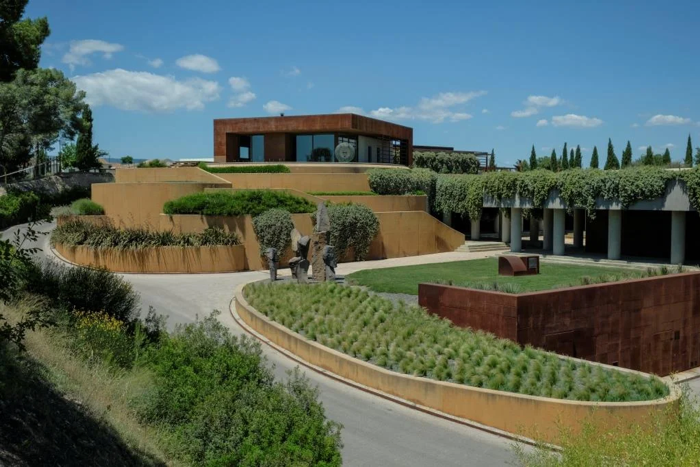
Bodegas Torres, located in the beautiful region of Vilafranca del Penedès in Catalonia, is a must-visit destination for wine lovers. Founded in 1870, this family-run winery has maintained its commitment to quality and innovation through five generations.
With extensive vineyards stretching across the rolling hills of Penedès, it is the epitome of Catalan winemaking tradition combined with the most modern techniques.
In addition to the stunning natural surroundings, Bodegas Torres offers an unforgettable wine tourism experience. From guided tours of the production facilities and exclusive tastings to outdoor activities in the vineyards.
What's more, their commitment to sustainability and respect for the environment is reflected in their farming practices and winemaking methods, which add an extra layer of charm to this magnificent place.
Famous Wines:
Known for wines like Viña Sol, Sangre de Toro, De Casta, Coronas, Atrium, and Viña Esmeralda. Their brandies, Torres 5 and Torres 10, are particularly notable.
Awards:
Jaime I brandy was awarded as the best brandy in the world at the World Brandy Awards in 2015. They have been recognized as the World's Most Admired Wine Brand by a British magazine.
Marqués de Riscal – El Ciego, Rioja Alavesa
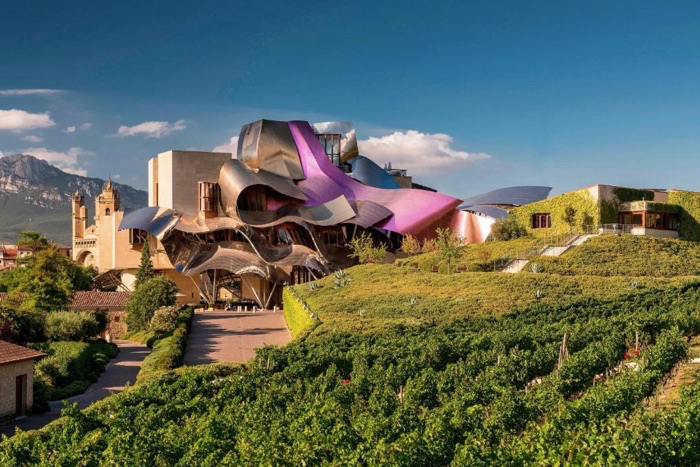
Marqués de Riscal, located in El Ciego, Rioja Alavesa, is a winery with a rich history and an innovative approach that makes it an essential destination for wine lovers. Founded in 1858, this winery has managed to combine winemaking tradition with modernity, standing out for its avant-garde architecture and cutting-edge production methods.
Also, its famous Frank Gehry-designed hotel offers visitors a unique experience combining art, architecture and nature.
Its vineyards extend over more than 200 hectares, offering ideal conditions for the cultivation of varieties such as Tempranillo, Graciano and Mazuelo. This diversity is reflected in its emblematic wines, which have an unmistakable aromatic complexity and elegance.
In addition, the winery is committed to sustainability and respect for the environment in all its winemaking practices.
Famous Wines:
Known for being the first ever Rioja wine bottled and the first non-French wine to win the diploma of honour of the Bordeaux Exhibition in 1895. They introduced the French variety Sauvignon Blanc in Rueda and began producing Barón de Chirel in 1986, a precursor of the “New Style” era in Rioja Wines.
Awards:
The winery's wines, like the Marqués de Riscal and Barón de Chirel, have received various awards and recognitions over the years
Dinastia Vivanco – Briones, La Rioja
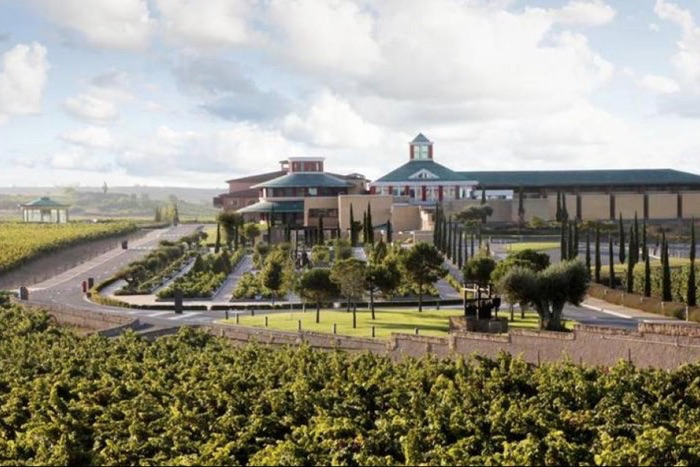
The best thing about the Dinastía Vivanco in Briones, La Rioja, is its commitment to the art and culture of wine. This museum offers a unique experience for wine lovers, with its extensive collection of art related to viticulture and oenology.
Visitors can immerse themselves in the history of wine from ancient times to the present day, providing a fascinating insight into how this drink has evolved over the centuries.
In addition, the impressive vineyard surrounding the museum gives visitors the opportunity to get an up-close look at traditional and modern winemaking practices. The winery also offers guided tastings that allow visitors to explore a wide range of exceptional wines.
Awards and Recognitions:
- 2017: National Prize of Gastronomy in the Special Category for the Family and Foundation Vivanco.
- 2014: Medal of Villa de Tudelilla for archaeological work.
- 2008: Gourmand World Cookbook awards winner for best illustration and photography in books.
- 2007: UNWTO Ulysses Award for Innovation in Non-Governmental Organizations.
- 2005: Oenovideo Award at the International Grape & Wine Film Festival.
- Numerous Best of Wine Tourism Global Awards in various categories.
Bodegas Protos – Peñafiel, Castilla y León
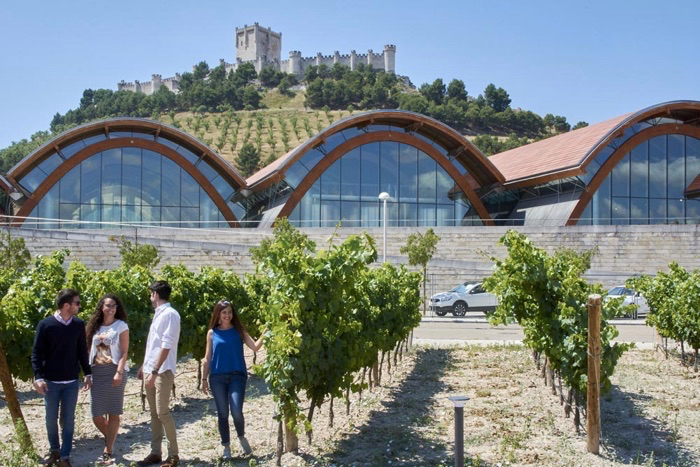
Bodegas Protos, located in Peñafiel, Castilla y León, is one of the pioneering wineries in the Ribera del Duero wine region. Renowned for its high-quality red wines, this winery has stood out for its unique style and commitment to winemaking excellence.
With vineyards located along the Duero River, Protos benefits from a privileged terroir that gives its wines a distinctive personality and character.
Since its founding in 1927, Bodegas Protos has maintained a firm commitment to innovation and the preservation of Spanish winemaking traditions. Its focus on the use of modern technologies coupled with artisanal methods has enabled the creation of unique wines that faithfully reflect the terroir and climate characteristic of Ribera del Duero.
In addition, its iconic underground cellar carved directly into the rock is testimony to the deep cultural and historical roots that distinguish this prestigious winemaking house.
Famous Wines:
The winery's notable wines include Protos Verdejo, Protos Verdejo fermentado en barrica, Protos Roble, and Protos Reserva.
Awards and Recognitions:
Received 4 Gold Medals at the China Wine & Spirits Awards for the above-mentioned wines.
Marqués de Murrieta – Logroño, La Rioja
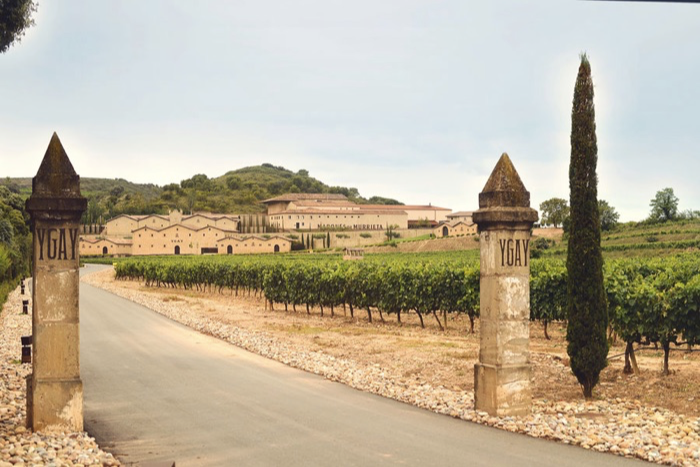
Arriving at Marqués de Murrieta is like entering the very history of wine in La Rioja. Founded in 1852, this winery is one of the oldest in the region and has maintained its traditional winemaking methods, making it an icon of classic Rioja wine.
The estate, located near the city of Logroño, covers more than 300 hectares of vineyards that stretch along the valley of the Ebro River, offering the perfect conditions for growing grapes.
What distinguishes Marqués de Murrieta wines is their unmistakable character. Their red wines show an elegant complexity and remarkable longevity, thanks to long periods in barrel and bottle. However, their commitment to innovation has also led them to experiment with other styles such as barrel-fermented whites and sparkling cavas.
This combination of tradition and adaptation to the modern market has allowed them to remain in force for more than a century and a half, being an undisputed benchmark in Spain and abroad.
Famous Wines:
Particularly known for its Castillo Ygay Gran Reserva.
Awards and Recognitions:
- Earned a place among the top 10 wineries worldwide with the highest number of Parker points.
- 100 Parker points in five vintages: 1904, 1919, 1934, 1959, 1964.
- Winemaker María Vargas was named "Best Winemaker in the World" at the Women in Wine Spirits Awards 2021.
- Castillo Ygay Gran Reserva was awarded "Best Wine of the Year 2021" by Wine Spectator.
- Received the international "Best Of 2023" award as the best winery in the world by the Great Wine Capitals Global Network.
Bodegas López de Heredia ‘Viña Tondonia’ – Haro, La Rioja
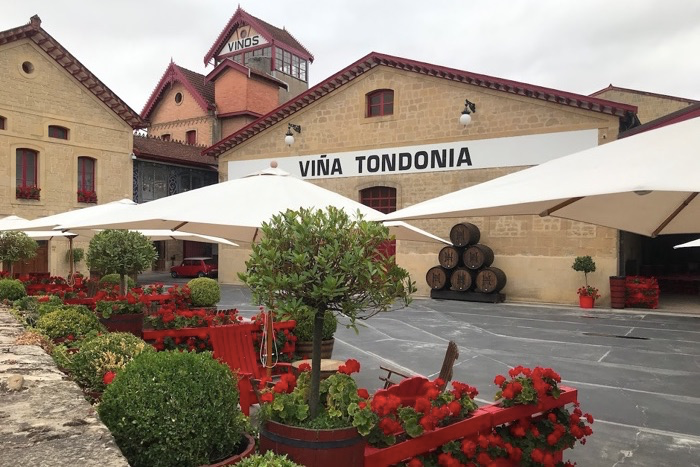
Bodegas López de Heredia, located in Haro, La Rioja, are renowned as producers of some of the region's most traditional and respected wines. Among their outstanding labels is Viña Tondonia, whose reputation has transcended borders thanks to its quality and distinctive character.
This iconic red wine stands out for its longevity, proving that patience in winemaking is a virtue that pays off.
The winery has maintained an artisanal and traditional approach to its winemaking process, using centuries-old methods that have earned it worldwide recognition. The winery's own vineyards provide carefully selected grapes to ensure excellence in every bottle.
History, tradition and passion merge to give life to wines that reflect the Rioja terroir with elegance and authenticity.
Famous Wines:
- Viña Tondonia: red, white, and rosé wines.
- Viña Bosconia: red wines.
- Viña Cubillo: red wine (Crianza only).
- Viña Gravonia: white wine (Crianza only)
Awards and Recognitions:
- The Viña Tondonia Blanco 1964 is considered a legendary wine. It has received high praise from wine critics and experts.
- John Gilman declared the 1964 vintage as "the single greatest white Rioja," while Hugh Johnson compared it to Haut-Brion, noting its longevity and vitality even decades after its production. The wine was acclaimed for its balance, complexity, and profound finish, being a fine example of the winery's traditional ageing process and the quality of its vintage wines
Bodegas Freixenet – Sant Sadurní d’Anoia, Catalunya
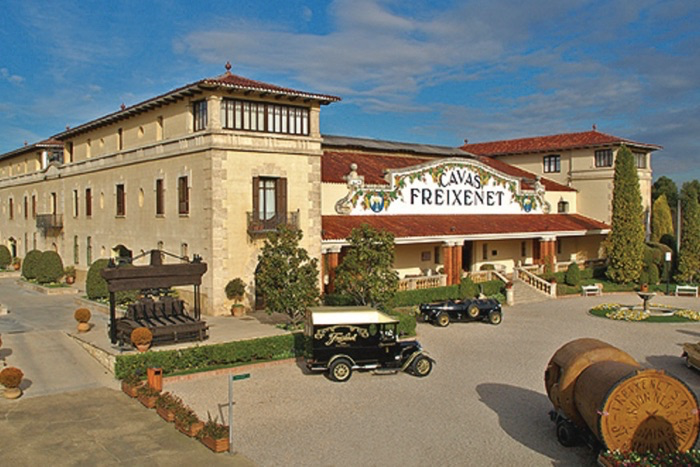
The Freixenet winery, located in Sant Sadurní d'Anoia, Catalonia, is renowned worldwide for its excellence in the production of sparkling wines, especially cava. The winery has a long history dating back to the 19th century and has been instrumental in popularising cava outside Spain.
Its production process combines tradition and innovation to create unique flavours and unparalleled quality.
The Sant Sadurní d'Anoia region, with its Mediterranean climate and chalky soils, provides ideal conditions for growing the grapes used to make cava. The winery takes great care in every detail of the process, from the selection of the grapes to the fermentation method, resulting in a final product that is exceptionally balanced and full of character.
In addition, Bodegas Freixenet has maintained its commitment to environmental sustainability through environmentally friendly agricultural practices. This holistic approach ensures exceptional wines and a positive impact on the surrounding natural environment.
Famous Wines:
Their sparkling wines have been awarded, including Segura Viudas Brut Reserva (silver medal at Decanter World Wine Awards 2020), Lavit Brut Nature, Elyssia Gran Cuvée and Freixenet Cordón Negro.
Awards:
The Freixenet Group has won several medals at prestigious awards like the Decanter World Wine Awards.
Bodegas Codorniu – Sant Sadurní d’Anoia, Catalunya
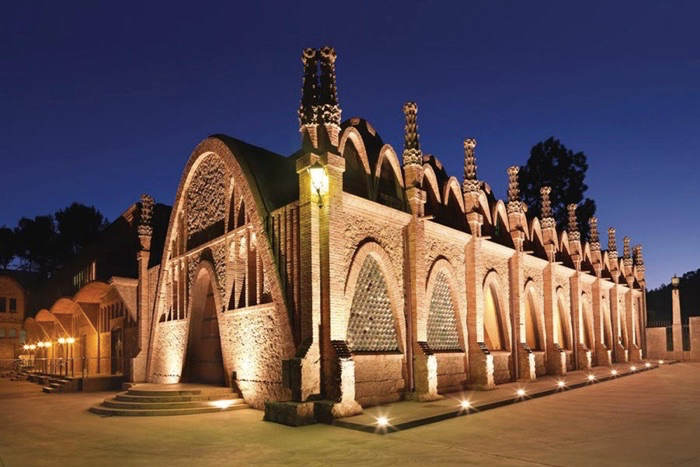
Bodegas Codorniu, located in Sant Sadurní d'Anoia, Catalonia, is one of the oldest family-owned wineries in Spain and one of the world's leading producers of cava. With more than 450 years of history, this winery has maintained its family legacy and commitment to excellence in sparkling wine production.
Innovation has been fundamental to the continued success of Bodegas Codorniu. Its pioneering use of the traditional champenoise method in the production of cava was revolutionary for the Spanish wine industry. In addition, its commitment to sustainability and the preservation of the winemaking heritage has made this winery a benchmark in the sector.
A visit to Bodegas Codorniu offers wine lovers a unique experience to explore its extensive underground cellars and learn about the cava-making process. The rich history and tradition combined with cutting-edge technology make this winery a must-see destination for those who wish to immerse themselves in the world of cava.
Famous for:
The oldest and second-largest producer of Cava.
Recognition:
Its cellars were declared a "National Monument of Historical and Artistic Interest" by King Juan Carlos I in 1976.
Ramón Bilbao – Haro, La Rioja
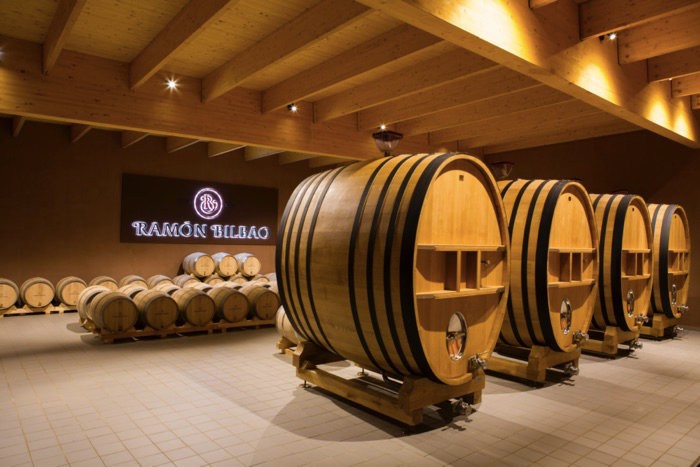
Ramón Bilbao, located in Haro, La Rioja, stands out for its modern approach to winemaking while respecting traditional Rioja styles. This winery combines innovation with respect for the region's centuries-old winemaking techniques.
By employing new technologies and taking care at every stage of the winemaking process, Ramón Bilbao achieves wines that reflect the unique character of the Rioja terroir.
The commitment to excellence is reflected in every bottle that leaves this winery. Through the precise use of oak and meticulous hand-selection of grapes, Ramón Bilbao wines are the perfect blend of tradition and innovation.
Furthermore, their ability to adapt to changing tastes without sacrificing quality demonstrates their ability to remain relevant in a dynamic market.
Recognition:
Named one of the 50 most admired wine brands in the world by Drinks International magazine in 2019, placing 40th. This marked a historic milestone for the winery, highlighting its innovation and sustainability efforts.
Campo Viejo – Logroño, La Rioja
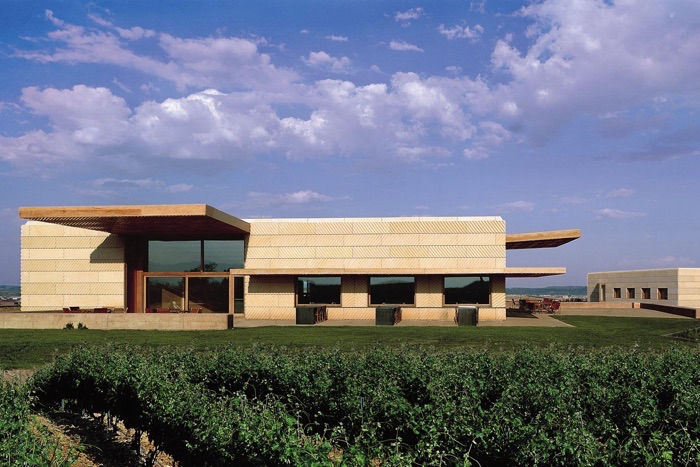
Campo Viejo is a renowned winery located in Logroño, La Rioja, famous for its accessible and widely enjoyed Rioja wines. With over 60 years of history, the winery has perfected the art of winemaking, combining tradition and innovation to create wines that are true masterpieces.
A distinguishing feature of Campo Viejo is its commitment to sustainability and respect for the environment. The winery has implemented ecological practices and advanced technology to reduce its impact on the natural environment, demonstrating a strong commitment to environmental responsibility.
In addition, the passion for excellence and quality is reflected in every bottle, offering a unique sensory experience to wine lovers seeking exquisite flavours and aromas.
The cultural and historical legacy of La Rioja merges with Campo Viejo's winemaking expertise to create wines that capture the very essence of the terroir.
Famous Wines:
Known for pioneering the iconic ‘Rioja bottle’ and their unique Tempranillo Blanco wine.
Awards and Recognition:
First Spanish winery certified as carbon neutral in 2012. Notable for its underground winery providing natural insulation, and a specialized research centre for wine innovation.
Conclusion
In short, Spain's leading wineries offer an exciting journey through the history and culture of wine. From the traditional Bodegas Torres in Catalonia to the innovative Marqués de Riscal in Rioja Alavesa, each brings a unique flavour to the country's rich winemaking tradition.
These places not only stand out for their exquisite wines but also for their commitment to sustainability and respect for the environment. Spain thus remains an essential destination for wine lovers, where quality and tradition intertwine to create unforgettable experiences.
FAQs
What is the largest winery in Spain?
Bodegas Torres is recognized as the largest winery in Spain. With a history spanning nearly 150 years, the Torres family has developed an extensive international operation, distributing their wines to over one hundred countries worldwide.
What are the main wine regions of Spain?
The main wine regions of Spain include Rioja, Ribera del Duero, Priorat and Penedès.
What are some of the most common grape varieties in Spanish wines?
Some common varieties include Tempranillo, Garnacha, Monastrell and Albariño.
What makes Spanish wines unique compared to other wine-producing countries?
The diversity of climates and soils, as well as the long history of winemaking, give Spanish wines a unique diversity and complexity.
What is the difference between a bodega and a wine cooperative in Spain?
A bodega is a private company that produces its own wines, while a wine cooperative is collectively owned by several winegrowers who share facilities to produce wine.
What is the classification process for wines in Spain?
Spanish wines are classified according to Denominación de Origen (DO), Denominación de Origen Calificada (DOC) or Vino de la Tierra (VdT).
What is the meaning of the term Crianza on Spanish wine labels?
Crianza indicates that the wine has been aged for a specific minimum period before being released to the market.
What wine-related events or festivals are held in Spain annually?
Some notable events include the Fiesta de la Vendimia in Jerez, the Batalla del Vino in Haro and the Feria Nacional del Vino in Valdepeñas.
How can I visit the most important wineries and vineyards in Spain?
Many wineries offer guided tours and tastings. It is recommended that you contact the wineries directly to schedule a visit.
You May Be Also Interested in
- Types of Spanish Wines
- Winemaking Process in Spain
- Viticulture in Spain
- Denominaciones de Origen (designations of origin) of Spanish wines
- Spanish Food and Wine Pairings
- Spanish Rosé Wine Guide
- 5 Spanish Wines to Serve with Vegetable Dishes
- An introductory guide to Spanish wine
- Spain’s 10 most expensive red wines